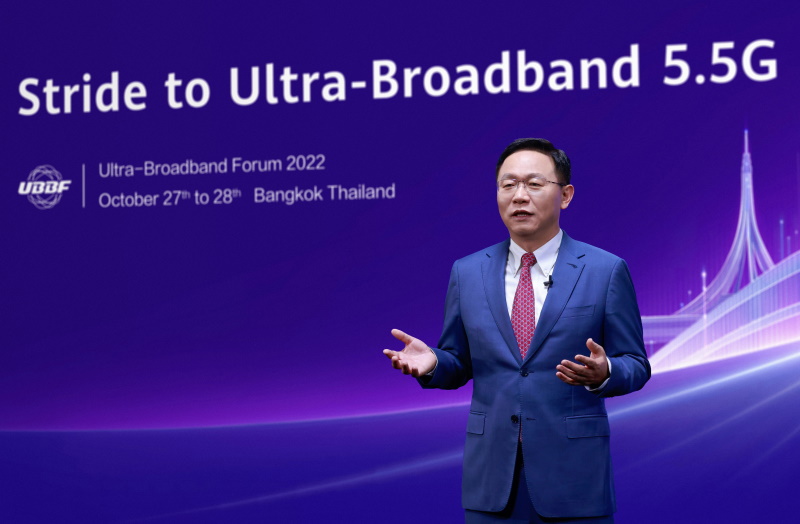
Huawei Promotes Low-Carbon 5G Networks - Ultra-Broadband 5.5G, key milestone on the path to an intelligent world
Following its 2 days Global Mobile Broadband Forum 2022 (MBBF2022), Huawei Ultra-Broadband Forum 2022 raised its curtain today in Bangkok. David Wang, Huawei's Executive Director of the Board and Chairman of the ICT Infrastructure Managing Board, delivered a keynote speech titled Stride to Ultra-Broadband 5.5G, outlining the enormous changes that are set to take place in areas like smart homes, smart campuses, and industrial Internet by 2030. He also made it clear that ultra-broadband 5.5G will be a key milestone on the path to an intelligent world and recommended that the industry take four key steps to accelerate this process. He went on to call on all industry players to work together and move faster towards ultra-broadband 5.5G.
As we approach the intelligent world of 2030, home broadband speeds will reach 10 Gbit/s, marking a huge improvement over today's 1 Gbit/s experience. Currently, homes have an average of 5 to 20 devices connected to their Wi-Fi networks. However, this is set to change as smart home devices see broad adoption, which will drive this number up to 150 to 200. It will therefore be essential that fiber can reach every room of every home.
.jpg)
By 2030, Wi-Fi networks will also be capable of delivering several 10 Gbit/s experiences for mid- and large-sized campuses, and will need to support intelligent operations and management. Micro and small enterprises will need Wi-Fi networks that can deliver large bandwidth, premium experiences, and one-stop intranet services. Industrial Internet will require a bandwidth higher than 10 Gbit/s and a latency lower than one millisecond. Enterprises will adopt a multi-cloud strategy that requires networks to dynamically adjust routing. Driven by green development and automation, we will see 10-fold increases in network capacity, energy efficiency, and O&M efficiency.
"Ultra-broadband 5.5G will be a key milestone on our path to this intelligent world. To hit this milestone, all industry players, including standards organizations, regulators, operators, and equipment vendors, will need to work together. I would like to call on you all to continue working together. Let's leverage ultra-broadband 5.5G technologies, build 5.5G networks, and develop a 5.5G ecosystem. Together, we will move our industry forward and stride to ultra-broadband 5.5G," stressed Wang.
Wang stated the four steps the industry must take to reach ultra-broadband 5.5G. First, defining next-gen standards and reaching consensus across the industry. Second, jointly promoting the rapid adoption of standards across entire product lifecycles, from technological breakthroughs to product development, deployment, and operations. Third, rolling out ultra-broadband 5.5G more quickly using policies and target networks. Fourth, exploring new applications and building a prosperous ecosystem.
Huawei believes the telecom industry will need to cooperate with industrial Internet companies as they continue working on deterministic experience and flexible routing in support of industrial Internet. This will help incubate applications for automated industrial control and enterprise connectivity to multiple clouds.
The focus of green development in the communications industry is expected to shift from reducing energy consumption to improving energy efficiency. Multi-dimensional energy efficiency metrics cover both network performance and energy saving, and help operators manage carbon emissions reduction while guiding them towards target networks that feature optimal performance and energy efficiency. The International Telecommunication Union (ITU) has put multi-dimensional energy efficiency metrics in the proposed list of items to be included in its standards system, and plans to update the standards system in H1 of 2023.
At the 2nd day of Huawei Global Mobile Broadband Forum 2022 (MBBF2022), Huawei released its "3+1" Green Target Network concept. Under the new setup, "1" refers to an energy efficiency metric system, and "3" refers to the three fields of focus: green devices, sites, and networks. The new concept is designed to help operators build low-carbon and high-performing 5G networks that attract more traffic given the same amount of energy consumption.
Huawei is the first in the industry to achieve intelligent linkage between services and site auxiliary equipment with its GreenSite 2.0 solution. Aaron Jiang, President of Huawei's SingleRAN Product Line said, "Energy saving is an ongoing topic in the ICT industry. Improving energy efficiency while meeting service development requirements is the key to building low-carbon networks. Huawei will continue to develop innovative green solutions and promote their adoption on commercial networks, to help operators build green 5G target networks."
Yang Chaobin, President of Huawei ICT Products & Solutions and Huawei Wireless Solution, released a One 5G concept and set of solutions designed to facilitate the evolution of all bands to 5G. "5G is in the fast lane," Mr. Yang said. "The future calls for the evolution of all bands to 5G to deliver optimal performance and experiences with minimal energy consumption."
5G has developed at a rapid clip since first being commercially deployed three years ago, with network coverage, devices, and users all growing significantly. 5G delivers a more HD and immersive digital experience to consumers, and has accelerated digital transformation across industries. It has improved the way people work as well as the production efficiency of enterprises.



























